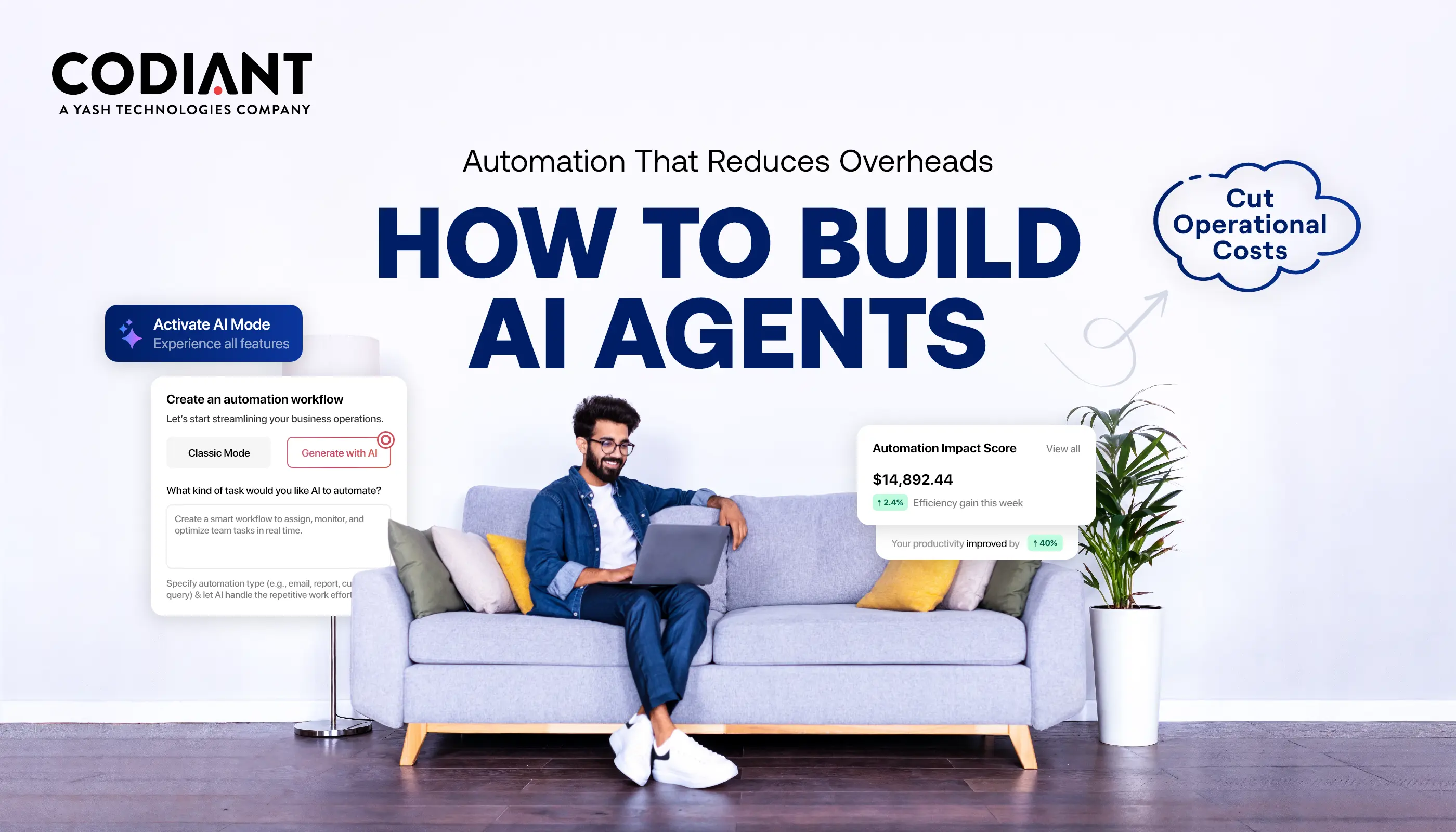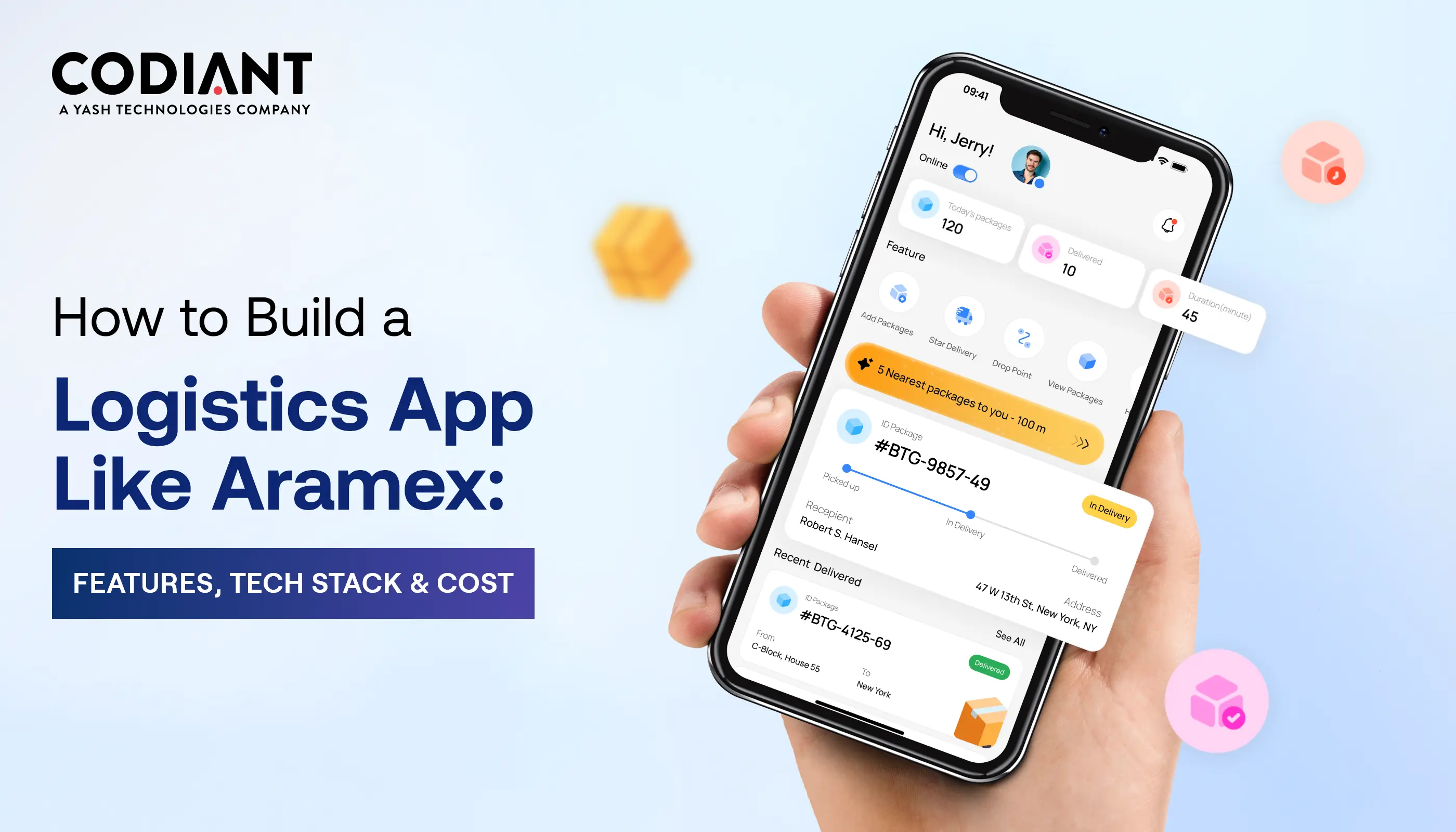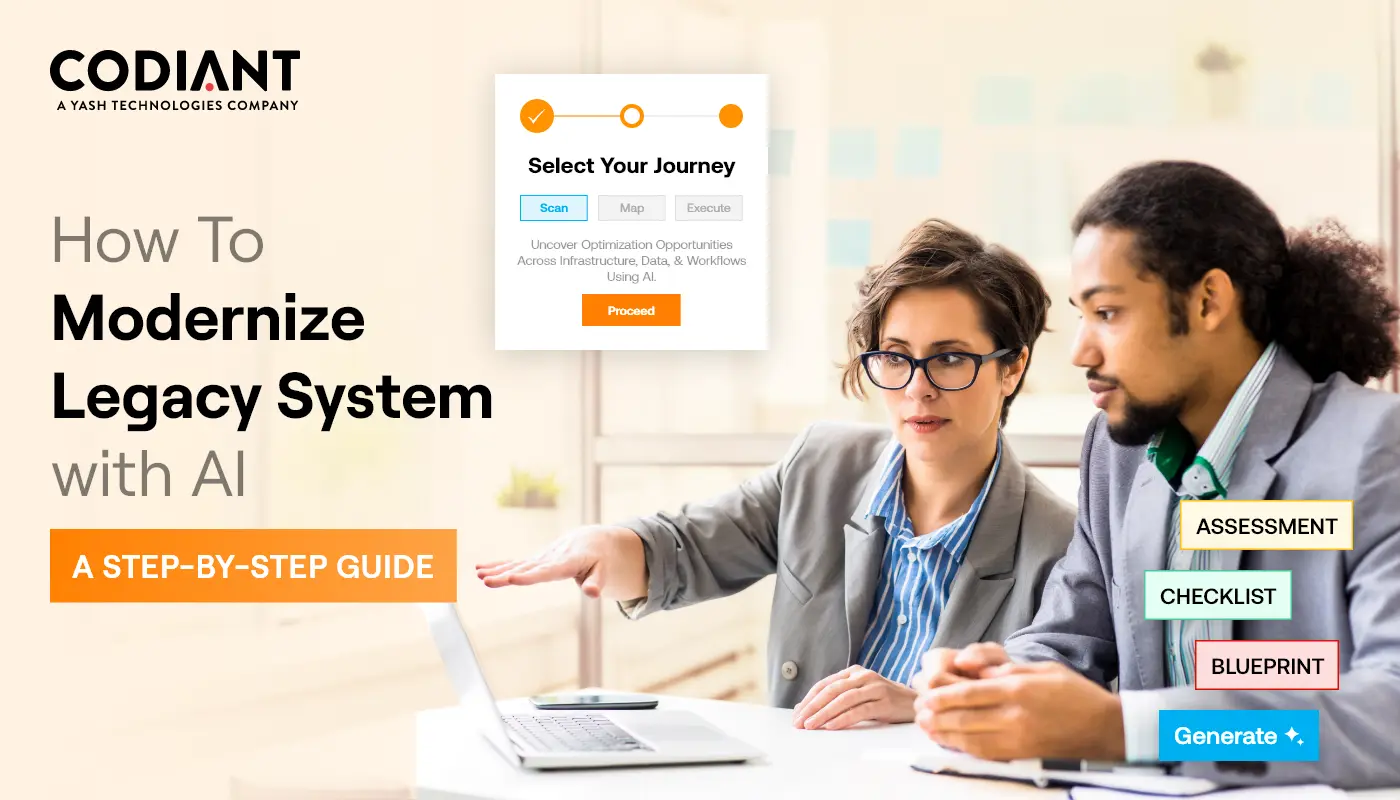Not All AI Agents Are the Same… So Which GenAI Solution Truly Fits Your Needs?
Table of Contents
Subscribe To Our Newsletter

Six months ago, a mid-sized company decided to explore AI to reduce inefficiencies in their operations. They started with a chatbot to answer routine queries. It worked well – until customers began asking about real-time updates, custom invoices and detailed breakdowns.
The chatbot didn’t know.
So, they upgraded to a smarter system that could pull live data. But soon, a department head asked – “Can it also compare vendor rates and generate draft reports?”
That’s when they realized:- not all AI is built the same.
Some respond. Some retrieve. Others act. And a few can plan, collaborate & make decisions on their own.
This blog unpacks that spectrum – from basic LLMs to fully autonomous Agentic AI. If you’re wondering which Generative AI solution truly fits your needs, keep reading.
LLM (Large Language Model) – The First Step
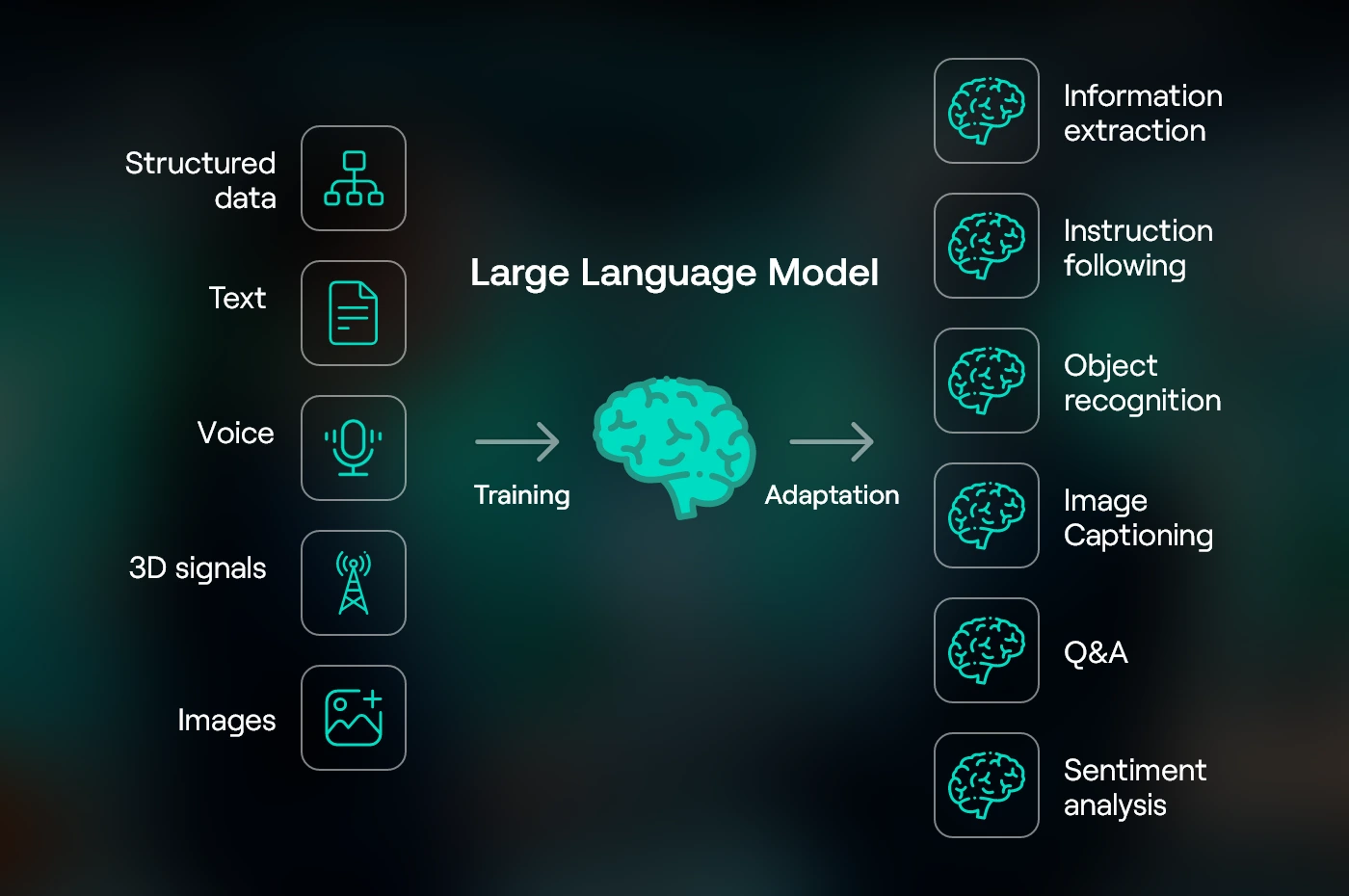
A Large Language Model or LLM development services, is the foundation of many AI applications today. It works by predicting the next word in a sentence based on the input it receives. LLMs are great for handling basic language tasks such as answering general questions, generating short content or offering grammar suggestions.
However, they have one major limitation – they can’t access real-time information or understand your personal data unless it was included in their training. This means their responses are based only on what they’ve previously learned not on live updates or your private context.
Real-World Examples:
1. LLM in E-Commerce Industry
Benefits of LLM in E-Commerce Industry
- Faster Product Description Generation
LLMs can create clear, keyword-optimized product descriptions in seconds – saving time for content teams and improving catalog readiness for seasonal or flash sales. - Improved SEO and Discoverability
By generating blog posts, meta titles & FAQs based on trending keywords, LLMs help e-commerce websites rank better on search engines without needing deep SEO expertise. - Enhanced Customer Communication
From auto-reply emails to live chat support scripts, LLMs handle large volumes of repetitive queries while maintaining a consistent tone and style. - Content Localization at Scale
LLMs support multiple languages and tones, enabling global sellers to launch region-specific campaigns without hiring language specialists. - Reduced Copywriting Costs
Brands can reduce reliance on external agencies or in-house content teams for basic copy needs, allocating resources to more strategic areas like UX or marketing. - Support for Seasonal Campaigns
Need a “Summer Sale” banner copy or festive blog ideas? LLMs can rapidly ideate and generate promotional content for high-conversion campaigns.
AI Capabilities Across E-Commerce
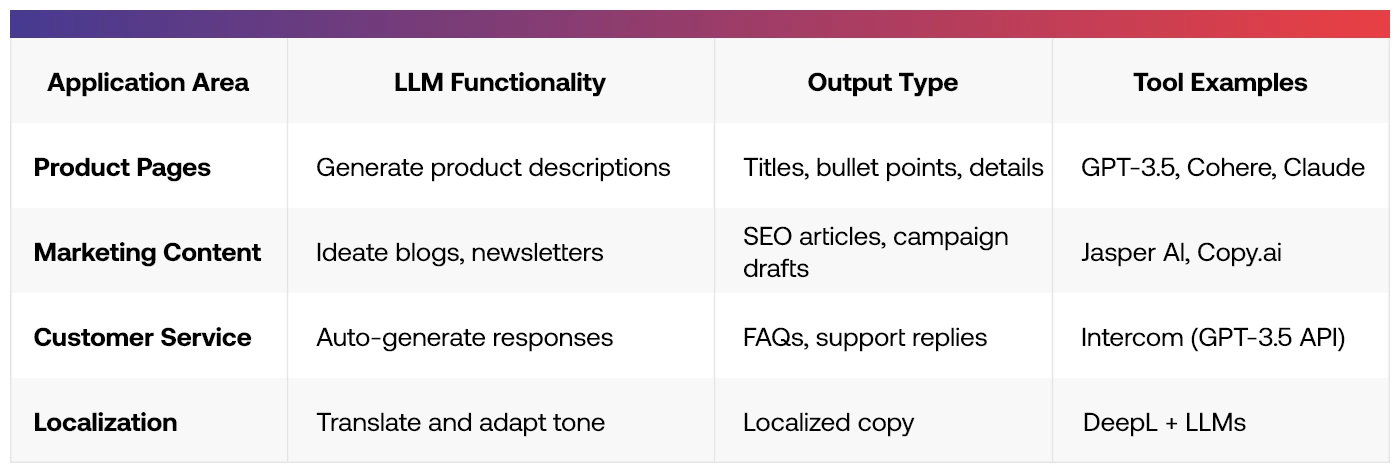
From Listings to Localization – LLMs Handle It All
Streamline your e-commerce ops with AI that writes, translates and updates at scale – without breaking flow.
Proven Business Impact
- 70% reduction in time-to-market for new product listings by auto-generating descriptions.
- 35% increase in organic traffic through AI-generated SEO blog content.
- 50% lower content creation cost by automating routine product and campaign copy.
- 2x faster localization for global campaigns with LLM-generated translations.
- 60% fewer customer support tickets by answering basic queries through LLM-driven bots.
2. LLM in Educational Industry
Benefits of LLM in Educational Industry
- On-Demand Language Support
LLMs help students understand grammar sentence structure & vocabulary in real-time – acting like a virtual language tutor available 24/7. - Personalized Learning Assistance
By simplifying complex concepts or summarizing lessons, LLMs support individual learning styles and help students grasp topics at their own pace. - Faster Content Drafting for Educators
Teachers and academic staff can use LLMs to draft lesson plans, quizzes announcements & learning materials more efficiently. - Enhanced Engagement in Remote Learning
LLM-powered chatbots or writing tools provide instant interaction, reducing the isolation often felt in digital classrooms. - Multilingual Educational Content Creation
LLMs can generate content in various languages, promoting inclusion for non-native speakers & conversational AI in education more accessible. - Academic Writing Support
Students receive help with thesis structuring, citation formatting, paraphrasing & proofreading, improving overall academic performance.
AI Capabilities Across Educational Industry
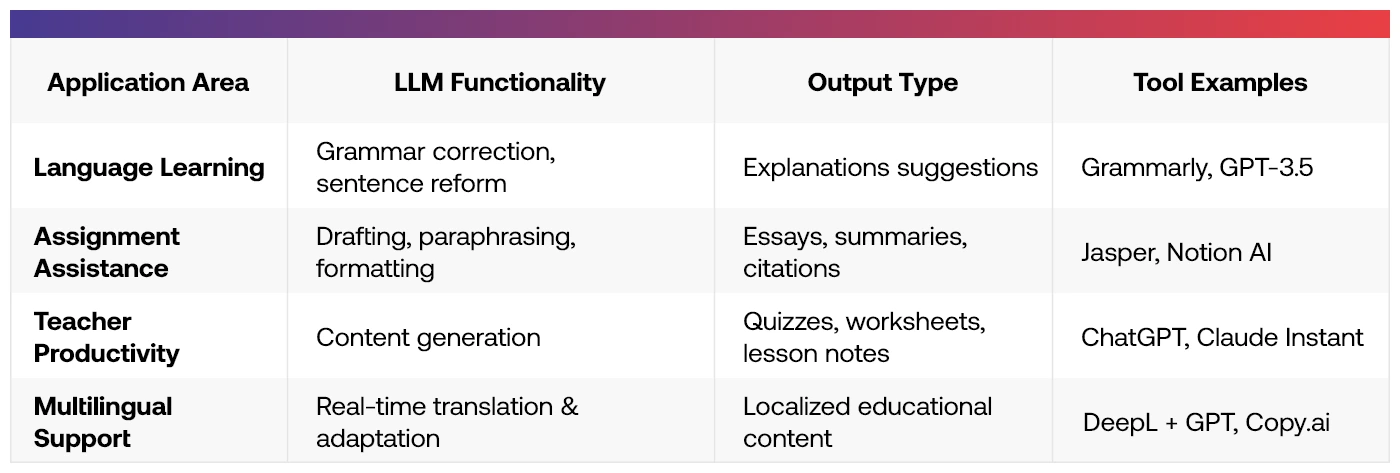
Proven Business Impact
- 40% reduction in teacher content drafting time by using AI to create lesson materials.
- 3x faster assignment turnaround for students receiving instant feedback and writing suggestions.
- 25% improvement in language test scores among ESL learners using LLM tools.
- 60% increase in digital engagement in online courses with AI-assisted chat and support.
- 50% cut in administrative workload for educators using AI to generate communications and reports.
3. LLM in Healthcare Industry
Benefits of LLM in Healthcare Industry
- Automated Patient Communication
LLMs help clinics send appointment reminders gentle reminder email, follow-up instructions & prescription alerts – reducing manual outreach by front-desk staff. - Quick Response to Common Queries
Chatbots powered by LLMs can answer frequently asked questions like clinic timings, insurance coverage or service availability – enhancing patient experience. - Support for Administrative Workflows
Medical assistants and staff can draft internal emails, announcement or standard reports using LLMs, saving time on routine documentation. - Simplified Medical Language
LLMs can translate complex medical terms into easy-to-understand language, helping patients comprehend diagnoses or instructions more clearly. - Multilingual Patient Communication
LLMs can generate multilingual messages making it easier to communicate with patients from diverse backgrounds without relying on human translators. - Triage Support and Information Routing
Though not a replacement for clinical judgment, LLMs can help route patients to the right department by analyzing initial inputs and keywords.
AI Capabilities Across Healthcare
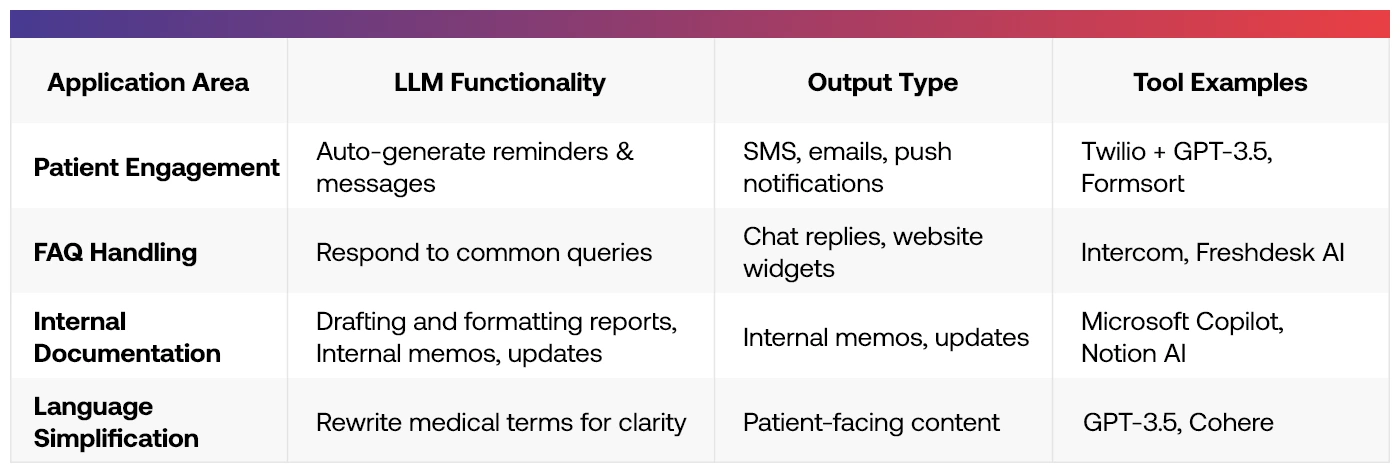
Proven Business Impact
- 65% reduction in front-desk workload through AI-generated appointment reminders & follow-ups.
- 40% decrease in no-show rates by sending timely, automated patient notifications.
- 55% faster response time to patient queries via LLM-driven chat interfaces.
- 3x improvement in patient comprehension for treatment instructions rewritten in simplified language.
- 30% reduction in translation costs by generating multilingual patient communications in-house using LLMs.
RAG (Retrieval-Augmented Generation) – The Game Changer
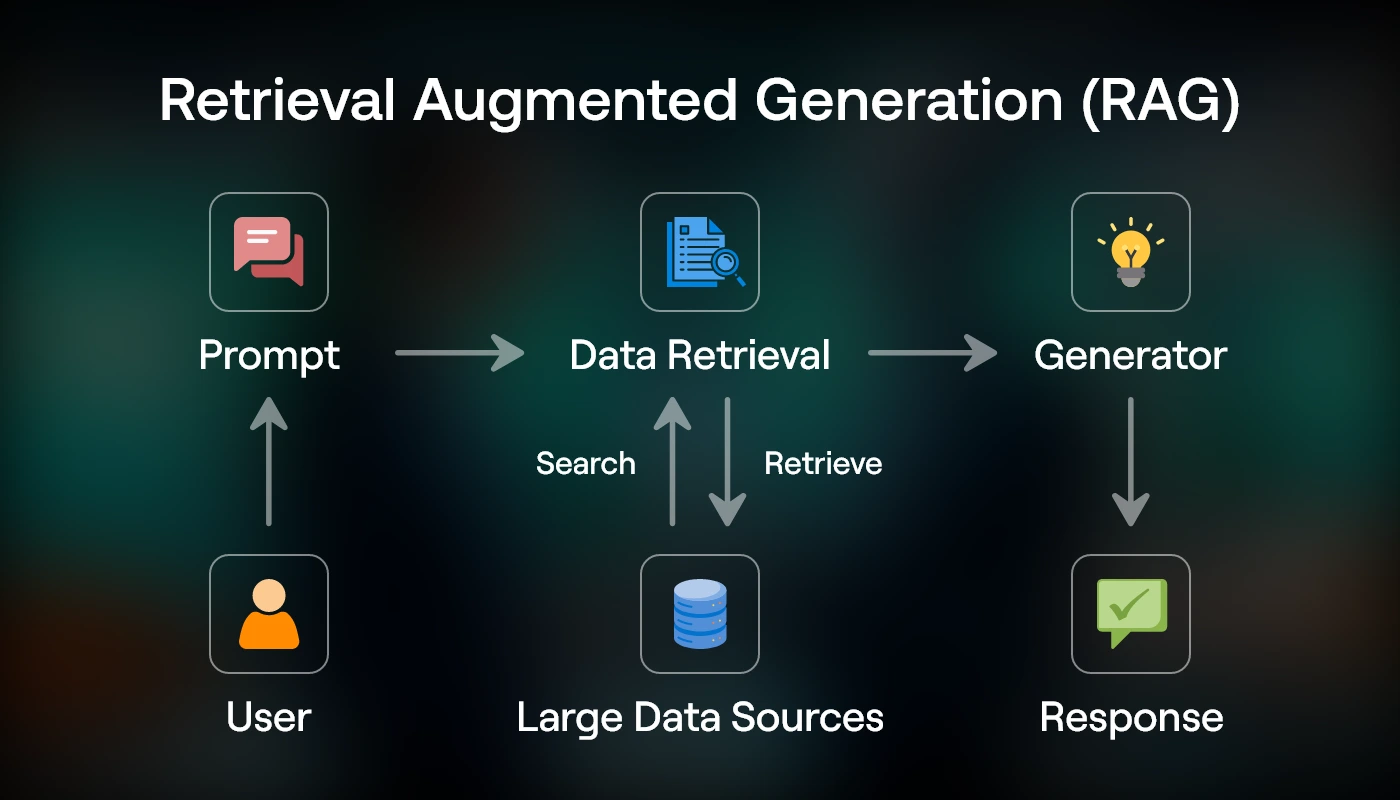
Most language models are limited to what they’ve already been trained on. That means if you ask them a question about your internal data – like a customer policy, financial record or contract – they won’t have the answer. This is where RAG (Retrieval-Augmented Generation) is useful.
It combines the power of a language model (like GPT) with a retrieval system that searches through external sources or private databases in real time. Instead of guessing, it pulls accurate, context-specific information from PDFs, knowledge bases or live document repositories, then presents a natural language response.
This makes RAG ideal for use cases where accuracy, personalization and domain-specific knowledge matter.
Real-World Examples:
1. RAG in Insurance
Benefits of RAG in Insurance
- Instant Access to Policy Data
RAG-powered systems retrieve real-time answers from brochures, T&Cs and internal PDFs – eliminating long hold times or agent delays. - Personalized Responses for Customers
Unlike static FAQs, RAG systems tailor answers based on individual policies, riders or claims—improving relevance and satisfaction. - Empowered Agents with On-Demand Support
Agents can ask complex queries like “What’s excluded in this critical illness plan?” and receive instant, accurate guidance pulled from training manuals or compliance documents. - Reduced Compliance Errors
Since answers are retrieved directly from approved documentation, the risk of miscommunication or unauthorized advice drops significantly. - Seamless Integration with CRMs and Support Tools
RAG systems development frameworks plug into existing CRMs or customer portals to surface contextual data inside workflows, improving both speed and usability. - Efficient Claims Pre-Screening
AI can compare incoming claim information against policy clauses in real time to determine eligibility, reducing manual review effort.
AI Capabilities Across Insurance
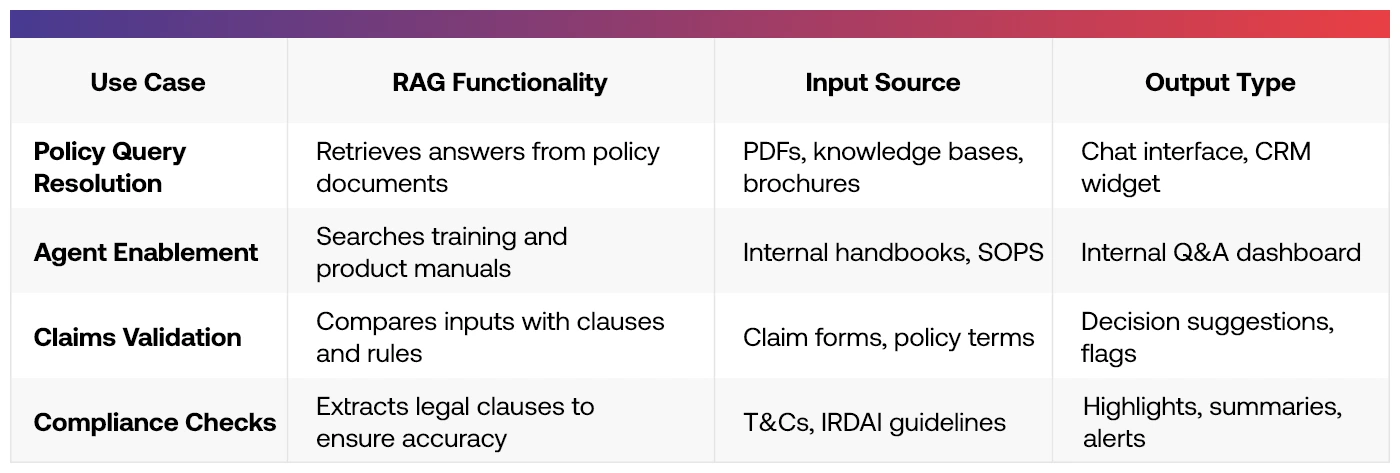
Proven Business Impact
- 80% faster query resolution for policy and rider-related customer questions using AI search.
- 45% fewer escalations as AI surfaces accurate and compliant answers on first contact.
- 2x improvement in agent productivity due to reduced time spent flipping through manuals.
- 60% drop in call center volume after integrating self-serve RAG chatbots.
- 30% faster claim triage enabled by AI comparing data with policy rules in real-time.
2. RAG in BFSI
Benefits of RAG in Finance
- Personalized Portfolio Insights
RAG models can analyze uploaded documents like mutual fund statements or tax reports and provide tailored insights such as portfolio performance or risk exposure. - Real-Time Financial Advisory
Customers can ask questions like “Which SIPs are underperforming?” or “Am I exceeding my 80C limit?” – and get responses grounded in their own data, not generic templates. - Accelerated Compliance Checks
Finance teams can instantly retrieve regulatory clauses or internal policy rules to verify actions, reducing the burden on legal and compliance departments. - Automated Document Analysis
RAG agents scan through P&Ls, balance sheets, or audit logs to extract relevant data, summarize key metrics and highlight anomalies or compliance flags. - Boosted Advisor Efficiency
Relationship managers can rely on RAG-powered systems to quickly retrieve data from CRM, risk models or product sheets – supporting faster, more informed client interactions. - Enhanced Customer Self-Service
With RAG embedded in client apps or portals, customers can independently explore and understand financial documents or product options in real time.
AI Capabilities Across Finance
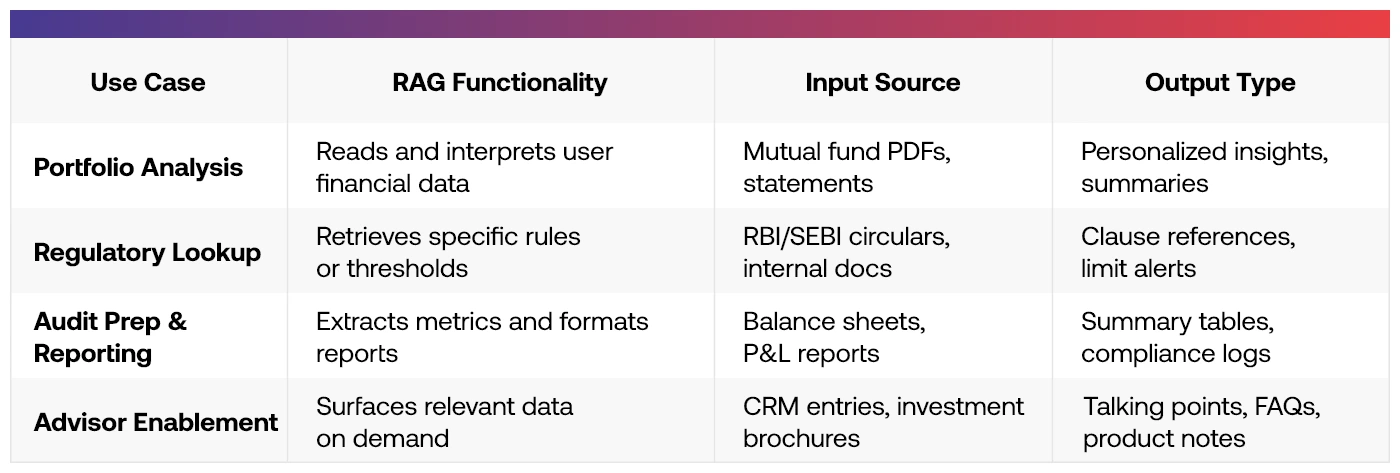
Unlock Precision Finance with RAG
Deliver hyper-personalized financial insights and automate compliance – faster, safer, and smarter with RAG-powered solutions.
Proven Business Impact
- 65% faster portfolio reviews by automating document analysis and insights generation.
- 50% increase in client satisfaction due to personalized financial guidance from agentic AI-driven systems.
- 40% reduction in advisory prep time for wealth managers using real-time RAG assistants.
- 3x faster retrieval of regulatory clauses during audits or internal reviews.
- 30% drop in back-office workload related to data extraction and compliance prep.
3. RAG in Legal Industry
Benefits of RAG in Legal
- Rapid Case Law Retrieval
RAG systems can search internal case law databases, past judgments, or regulatory guidelines in real-time – reducing the time lawyers spend manually digging through documents. - Context-Aware Contract Summarization
Upload a 50-page agreement, and RAG-powered tools will summarize obligations, renewal terms, risks or red flags within seconds – keeping legal teams focused on decisions, not scanning. - Internal Knowledge Management
Law firms can use RAG to pull relevant insights from previous case notes, memos and legal opinions, helping new team members get up to speed quickly. - Faster Due Diligence & M&A Reviews
From NDAs to shareholding structures, RAG agents can parse and flag unusual clauses, missing signatures or time-sensitive clauses – speeding up M&A workflows. - Improved Client Communication
Clients can query their own uploaded legal documents – “When does this lease expire?”—and get answers instantly, reducing dependency on legal back-and-forth. - Enhanced Compliance & Risk Checks
RAG systems compare documents against local laws and internal templates to surface deviations, expired clauses or high-risk terms.
AI Capabilities Across Legal
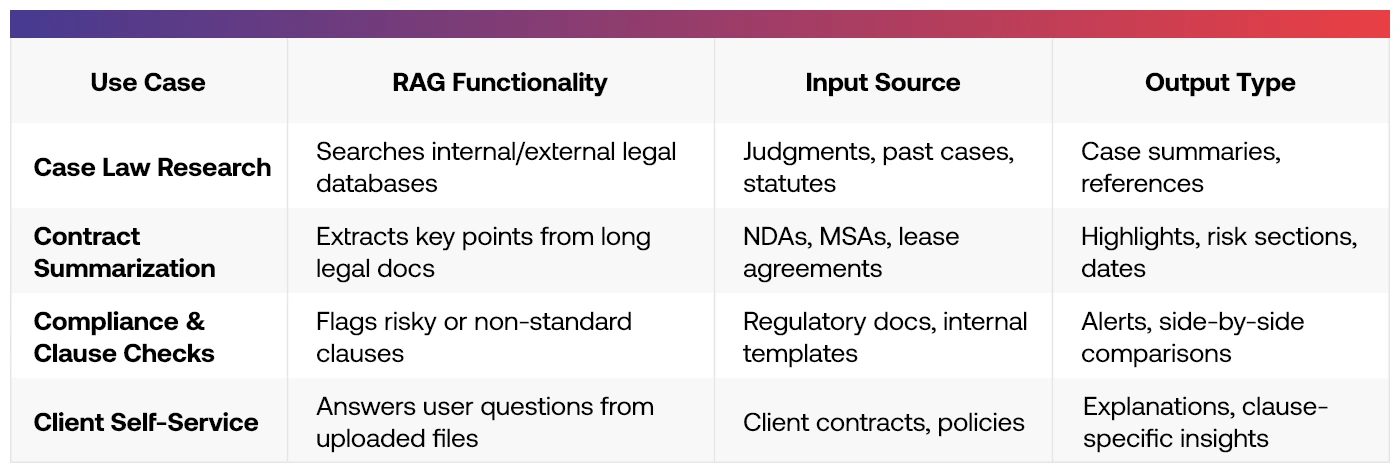
Proven Business Impact
- 75% faster contract reviews using AI-driven clause extraction and summarization tools.
- 60% time savings in legal research by automating case law and precedent searches.
- 45% reduction in compliance risk through real-time document comparison and deviation alerts.
- 2x increase in client query resolution speed via searchable document-based chat tools.
- 35% cost savings on external legal review hours by handling basic tasks in-house with RAG.
AI Agents – Autonomous Execution Begins
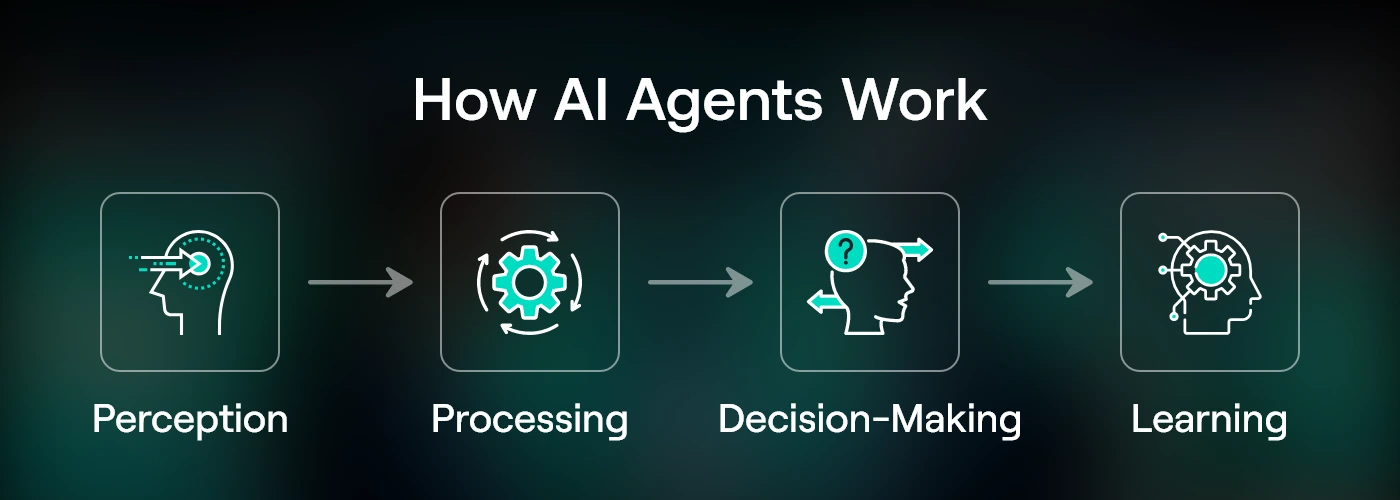
Unlike traditional chatbots or simple LLMs that just respond to inputs AI Agents are built to take action. They don’t just answer questions – they complete tasks, follow processes and remember context across sessions.
These agents are goal-driven systems. Once given an objective they can decide how to approach it, use APIs or tools to gather data, analyze results and take the next logical step – all autonomously.
What makes them different is their ability to:
- Plan and execute multi-step tasks
- Use external tools or search the web
- Retain memory across tasks and sessions
- Adapt based on feedback or new information
Real-World Examples:
1. AI Agents in Market Research
Benefits of AI Agents in Market Research
- Fully Automated Competitive Analysis
AI agents can independently search competitor websites, scrape key product features, pricing, reviews and summarize trends – saving analysts hours of manual work. - Web-Scale Data Collection
Instead of relying on a limited set of sources, AI agents scan the entire internet – from news articles to product listings – to gather real-time and broad-spectrum market data. - Fast Report Generation
Once data is collected, agents organize it into structured formats – tables, summaries, SWOTs or competitor matrices – allowing instant consumption for stakeholders. - Real-Time Updates on Market Trends
AI agents can run on a schedule (e.g., every week) to monitor changes in competitor offerings, emerging players or industry news – and send automated alerts or updates. - Language & Region Adaptability
These agents can extract content from multilingual sources and understand local nuances – crucial for region-specific market scans like “top food delivery apps in Saudi Arabia.” - Seamless Integration with BI Tools
Agents can feed insights directly into dashboards, CRMs or Google Sheets, enabling teams to view market intelligence alongside internal KPIs.
AI Capabilities Across Market Research
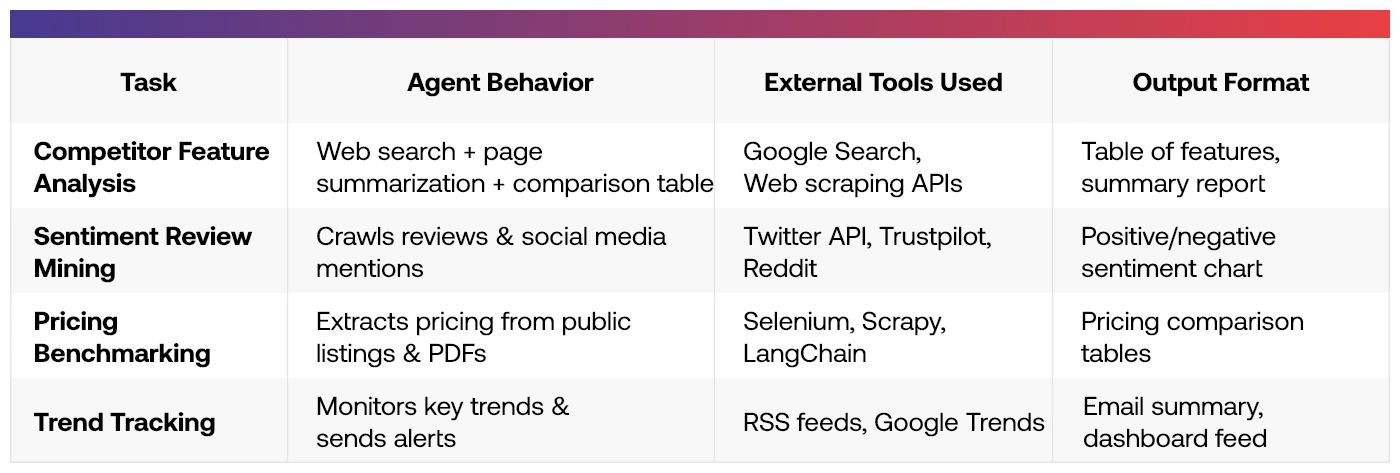
Proven Business Impact
- 80% reduction in time spent on competitor analysis using autonomous AI workflows.
- 5x faster turnaround on market research reports for product or sales teams.
- 60% cost savings on external market intelligence vendors.
- 2x increase in accuracy and freshness of insights by using real-time web scraping.
- 40% more opportunities identified through deeper analysis across regions and niche competitors.
2. AI Agents in Sales
Benefits of AI Agents in Sales Assistance
- End-to-End Lead Management
AI agents can automatically capture leads from multiple channels, enrich data via LinkedIn or CRM APIs and assign them to appropriate sales reps – without manual input. - Cold Email & Outreach Automation
The agent drafts personalized cold emails based on lead data, adjusts tone & templates based on past success rates, and schedules follow-ups – all autonomously. - Calendar Coordination & Booking
By accessing calendars and availability settings, AI agents can schedule meetings between leads and reps – reducing the constant back-and-forth emails. - Real-Time CRM Updates
AI agents log every action into the CRM – lead source, email status, call notes – ensuring data stays fresh and accurate without sales reps needing to update fields. - Continuous Learning from Outcomes
Over time, the agent analyzes which outreach patterns worked best and refines its messaging or lead prioritization based on conversions. - Sales Workflow Integration
Agents plug directly into existing tools like HubSpot, Salesforce, Gmail & Zoom – streamlining sales operations without disrupting current processes.
AI Capabilities Across Sales Workflows
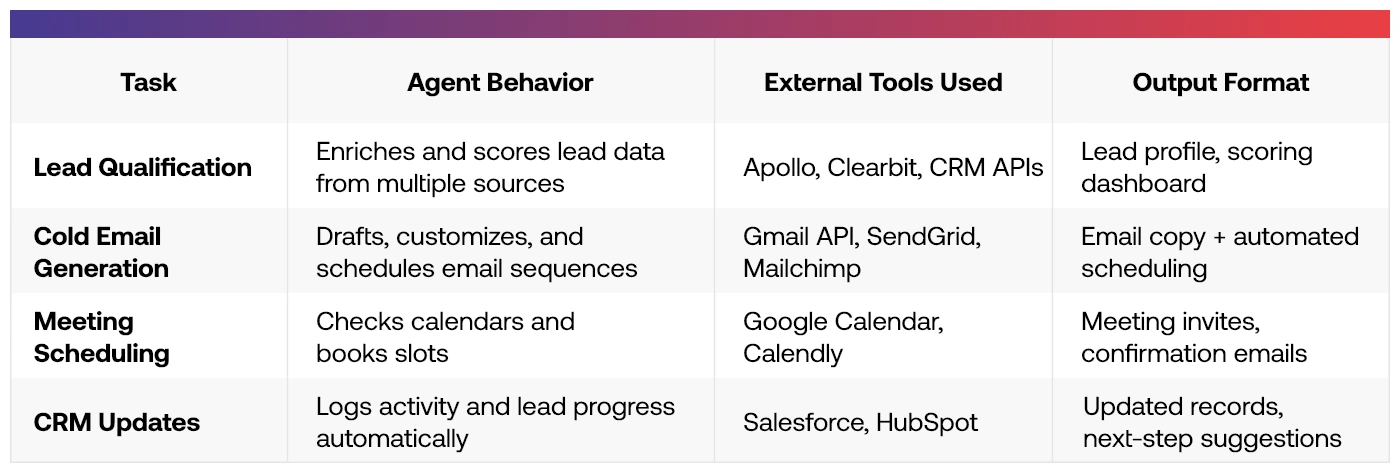
Proven Business Impact
- 3x faster lead response time by auto-initiating outreach within minutes of lead capture.
- 55% increase in meeting conversion rate by eliminating scheduling delays.
- 70% reduction in manual CRM entry time across sales teams.
- 40% more qualified leads processed per month due to autonomous triage.
- 25% uplift in email engagement rates through AI-personalized cold outreach.
3. AI Agents in Operations
Benefits of AI Agents in Operations & Procurement
- Automated Vendor Communication Handling
AI agents can monitor a shared inbox, detect incoming vendor quotes, and extract relevant details like pricing, delivery timelines & payment terms – without human intervention. - Real-Time Quote Comparison
The agent compiles all incoming quotes, compares key variables (e.g., price, delivery speed, terms) and recommends the best option based on procurement policies or priorities. - Purchase Order Drafting & Submission
Once a vendor is selected, the agent can auto-generate a purchase order draft with all pre-filled details and send it for approval – saving time and reducing data entry errors. - Seamless Integration with ERP Tools
AI agents can connect to systems like SAP, Oracle or Zoho Books to pull vendor history, match PO numbers & validate against budgets. - Smart Threshold & Policy Checks
Before proceeding, the agent checks if the quote is within budget, if terms meet compliance rules, or if the vendor is pre-approved – reducing financial or compliance risks. - Continuous Learning from Past Procurements
The agent refines its recommendation logic over time by learning from previous vendor ratings, feedback and fulfilment performance.
AI Capabilities Across Procurement Workflows
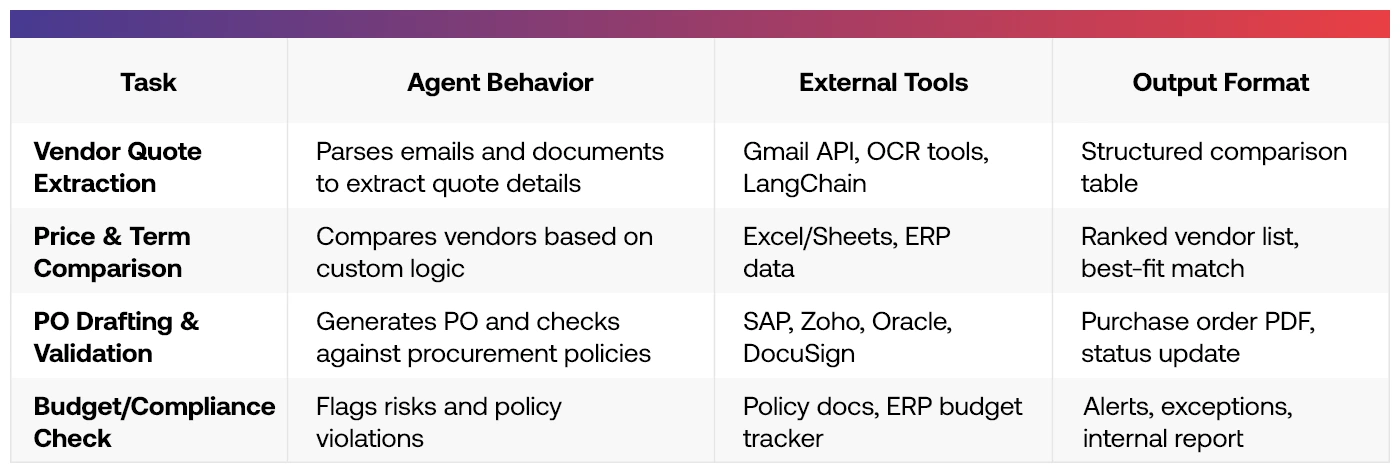
Proven Business Impact
- 65% faster procurement cycle from quote receipt to PO submission.
- 50% fewer errors in manual data entry or vendor selection.
- 3x increase in quote comparisons completed weekly through automation.
- 40% reduction in approval turnaround time for standard purchases.
- 30% drop in compliance violations due to built-in policy checks and vendor validation.
Agentic AI – When Multiple AI Agents Work as a Team
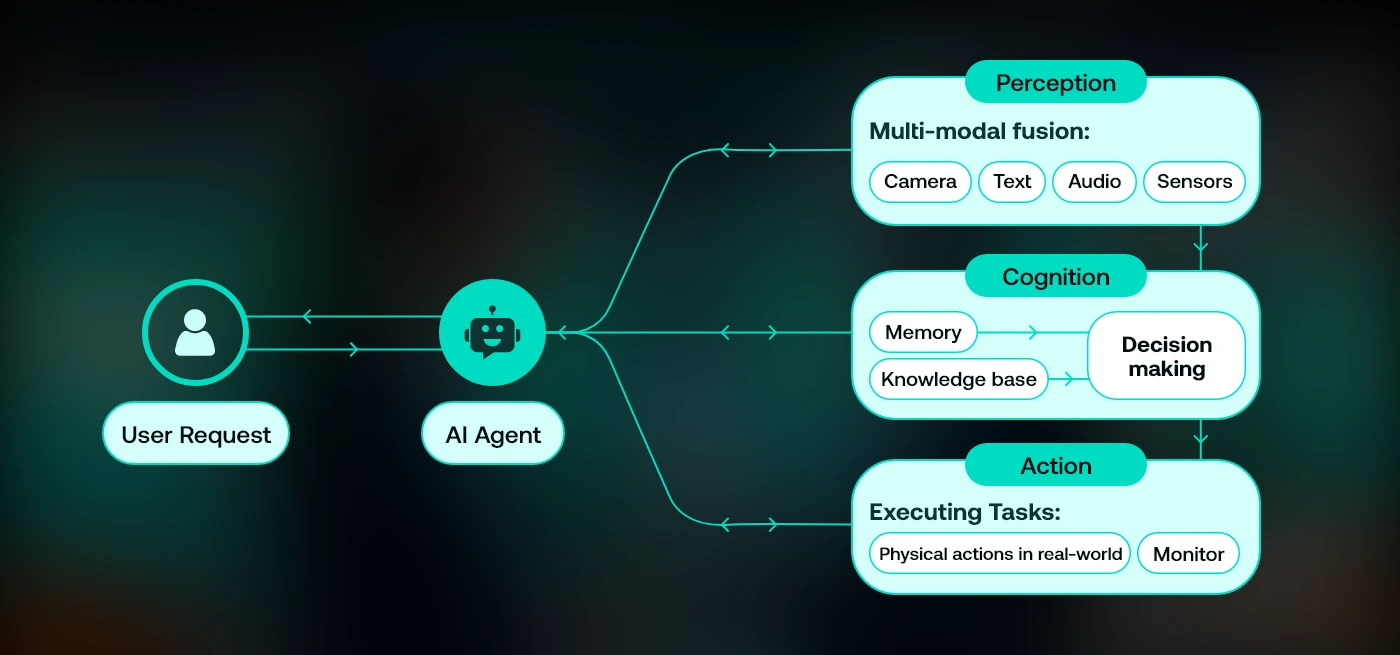
Agentic AI is not a single chatbot or assistant – it’s a network of AI agents that work together, each handling a specific role. They share information, remember context & coordinate tasks across time, almost like a small digital workforce that runs on its own.
Real-World Examples:
- Automating Business Operations: In a busy office one AI agent monitors emails and summarizes them. Another manages calendars and sets up meetings. A third pulls reports from spreadsheets every morning, while a fourth checks internal documents for policy issues.
Each agent runs independently but stays in sync with the others – working in the background without needing human follow-up. - Building a Product, Start to Finish: Platforms like ChatDev or MetaGPT simulate a full startup team. You give it a product idea, and AI intelligent agents take on roles like CEO, designer, developer & QA. They discuss, plan, write code, test it & iterate – without human input in between.
- Smart Travel Planning: You tell the system your destination and budget. One agent finds hotels, another keeps track of total costs, and a third handles the bookings. Together, they deliver a complete plan tailored to your goals.
AI Agents Examples
- Sales Follow-up Agent
Sends emails, checks your calendar, and books meetings with new leads. - Invoice Processing Agent
Reads vendor emails, pulls out invoice details, and updates your accounting system. - Blog Writing Agent
Researches topics, drafts SEO blogs, and schedules them for publishing.
Popular Tools: OpenDevin, AutoGen, SuperAgent, ChatDev, MetaGPT
Read more: Cost To Develop A Digital Transformation Strategy For US Businesses
What Do You Actually Need?
By now, it’s clear that not all AI systems serve the same purpose. Choosing the right one depends entirely on what you’re trying to solve.
Here’s a quick breakdown to help you decide which level of AI fits your current business needs:
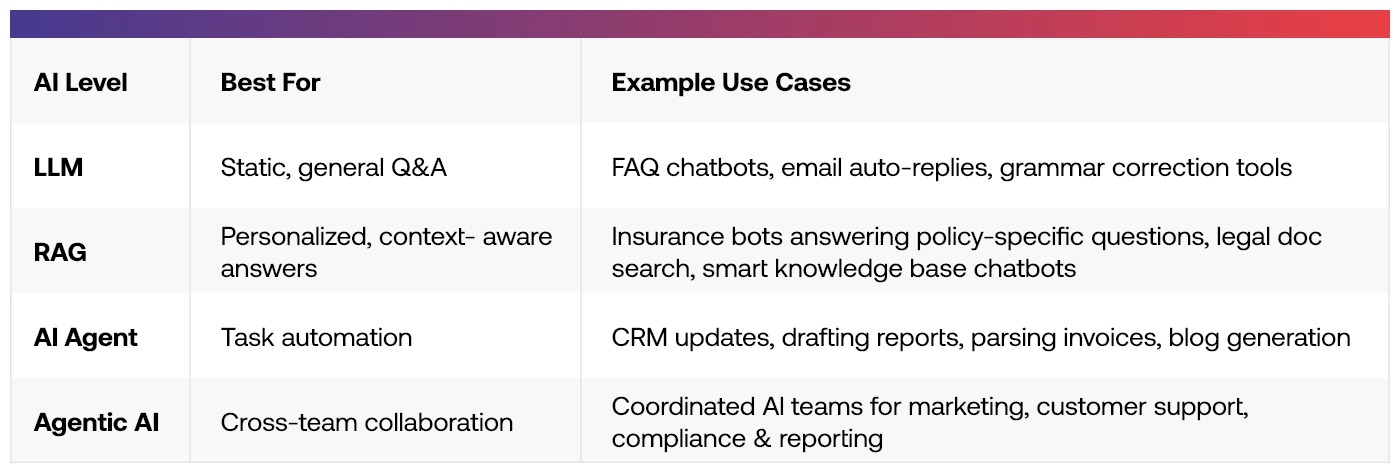
Final Thoughts: Choose the AI That Matches Your Goal
There’s no one-size-fits-all when it comes to AI. Some businesses just need a simple chatbot that can answer common questions. Others are ready to automate tasks or even run entire workflows using multiple AI agents. What matters most is knowing where you are today – and where you want to go.
If you’re just starting, an LLM-based solution might be all you need.
If accuracy and access to real-time company data is a priority, look at RAG systems.
If your team spends time on repetitive tasks, consider building an AI agent.
And if you’re managing large workflows across departments, Agentic AI can offer real long-term value. Get the best solutions with the reliable AI development company in USA.
Don’t invest in AI just because it’s trending – invest in the one that solves your actual problem.
Ready to Build the Right AI for Your Business?
Get expert guidance to design AI solutions that actually solve your business problems – not just follow trends.
Frequently Asked Questions
A chatbot usually just replies to your questions. An AI agent can actually perform tasks – like booking a meeting, writing a report or updating your CRM.
It depends on what you want to do. ChatGPT is great for general answers. But if you need AI that works with your private data or handles specific tasks, RAG or agents are more useful.
Not necessarily. If you have multiple processes that can be automated – like emails, reports or scheduling – Agentic AI can save you a lot of time, even in a small team.
Yes. Many companies start with basic LLMs or RAG systems, then add agents or Agentic AI as they grow. It’s better to start with a clear need and scale gradually.
Look at what you want AI to do. If it’s answering questions, LLM may be enough. If it needs to fetch internal data, RAG is better. If it should take actions, go for AI agents or Agentic AI.
Featured Blogs
Read our thoughts and insights on the latest tech and business trends
Learn How to Build AI Agents That Can Speed Up Your Work and Reduce Other Expenses
- November 10, 2025
- Artificial Intelligence
Businesses today are looking for faster ways to work and smarter tools that cut costs. That’s why AI agents are quickly becoming a key investment for companies of all sizes. These autonomous systems can perform... Read more
How to Build a Logistics and Transportation App Like Aramex?
- November 6, 2025
- Logistics & Transportation
In a Nutshell: A logistics app like Aramex helps businesses manage deliveries, track shipments, and serve customers better. Technology is now needed in logistics because customers want fast delivery and real-time tracking. A logistics app... Read more
How to Modernize Legacy Systems with AI – A Step-by-Step Guide
- October 31, 2025
- Artificial Intelligence
In a Nutshell: Legacy systems aren’t outdated - they’re underutilized. AI can modernize them without full replacement, saving time and cost. Modernization is a journey, not a rebuild. Start small with automation, data clean-up &... Read more

